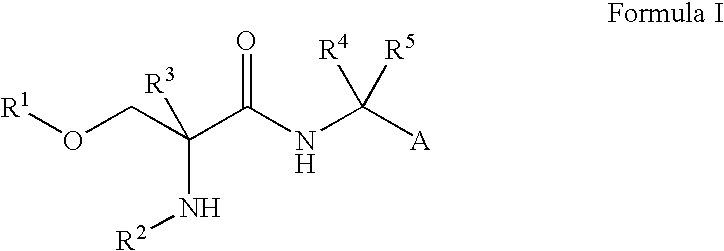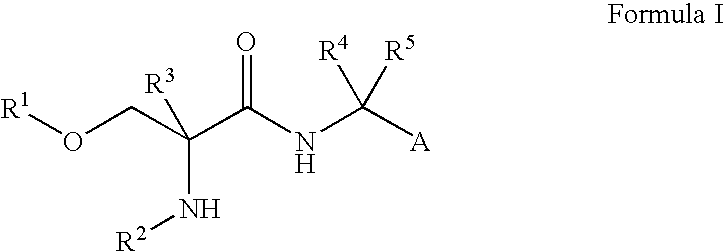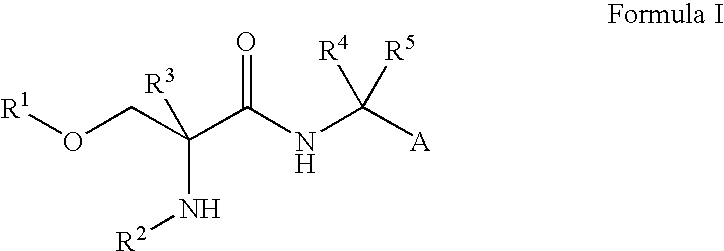Fluorinated Compounds
a technology of fluorinated compounds and fluorinated compounds, which is applied in the field of new drugs, can solve the problems of increasing the cost of treatment, so as to prevent or slow the appearance of symptoms, prevent or slow the effect of symptoms, and eliminate the causation of symptoms
- Summary
- Abstract
- Description
- Claims
- Application Information
AI Technical Summary
Benefits of technology
Problems solved by technology
Method used
Image
Examples
example 1.1
Methyl 2-(dibenzylamino)-3-hydroxypropanoate
[0079]
[0080]Methyl serine hydrochloride (15 g, 0.096 mol) was stirred with potassium carbonate (66.6 g, 0.482 mol) and benzyl bromide (41.2 g, 0.24 mol) in acetonitrile (240 mL) at room temperature for 24 hours. The reaction mixture was filtered and washed with ethyl acetate. The filtrate was concentrated with silica gel. The product was purified by column chromatography, eluting with 5-20% ethyl acetate in hexanes, to give methyl 2-(dibenzylamino)-3-hydroxypropanoate (27 g, 93.5%) as a pale-yellow sticky oil. 1H NMR (300 MHz, CDCl3): δ(ppm) 7.25-7.40 (m, 10H), 3.94 (d, 2H), 3.83 (s, 3H), 3.79 (m, 2H), 3.71 (d, 2H), 3.60 (t, 1H) and 2.62 (t, 1H).
example 2.1
Methyl 2-dibenzylamino-3-difluoromethoxy-propionate
[0081]
[0082]To an acetonitrile solution of methyl 2-(dibenzylamino)-3-hydroxypropanoate (23 g, 76.8 mmol) and sodium sulfate (3.9 g, 27.4 mmol) at 40° C., difluoro(fluorosulfonyl)acetic acid (25 g, 140 mmol) was added dropwise for 1.5 hrs. The reaction mixture was concentrated to dryness and the residue mixed with silica gel in ethyl acetate, then again concentrated to dryness. The product was purified by column chromatography, eluting with 3-4% ethyl acetate in hexanes, to give methyl 2-dibenzylamino-3-difluoromethoxy-propionate (1.3 g, 4.8%) as a colorless oil. 1H NMR (300 MHz, CDCl3): δ(ppm) 7.20-7.40 (m, 10H), 6.18 (bt, 1H), 4.05-4.24 (m, 2H), 3.90 (d, 2H), 3.83 (s, 3H) and 3.64-3.71 (m, 3H).
example 3.1
2-(Dibenzylamino)-3-(difluoromethoxy)propanoic acid
[0083]
[0084]Methyl 2-dibenzylamino-3-difluoromethoxy-propionate (1.2 g, 3.43 mmol) was stirred with 1N LiOH (10.3 mL, 10.3 mmol) in THF (40 mL) at 50° C. for 2 hours and then stirred at room temperature overnight. The reaction mixture was diluted with ethyl acetate and acidified with 1N HCl. The organic layer was dried with sodium sulfate and concentrated with silica gel. The product was purified by column chromatography, eluting with 10-50% ethyl acetate in hexanes, to give 2-(dibenzylamino)-3-(difluoromethoxy)propanoic acid (730 mg, 63.5%) as a white solid. 1H NMR (300 MHz, CDCl3): δ(ppm) 7.26-7.42 (m, 10H), 6.29 (bt, 1H), 4.45 (dd, 1H), 4.28 (dd, 1H), 3.94 (q, 4H) and 3.85 (m, 1H).
PUM
| Property | Measurement | Unit |
|---|---|---|
| temperature | aaaaa | aaaaa |
| body weight | aaaaa | aaaaa |
| body weight | aaaaa | aaaaa |
Abstract
Description
Claims
Application Information
 Login to View More
Login to View More - R&D
- Intellectual Property
- Life Sciences
- Materials
- Tech Scout
- Unparalleled Data Quality
- Higher Quality Content
- 60% Fewer Hallucinations
Browse by: Latest US Patents, China's latest patents, Technical Efficacy Thesaurus, Application Domain, Technology Topic, Popular Technical Reports.
© 2025 PatSnap. All rights reserved.Legal|Privacy policy|Modern Slavery Act Transparency Statement|Sitemap|About US| Contact US: help@patsnap.com



